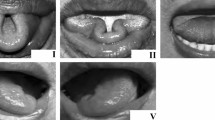Abstract
This study was performed to ascertain the relationships between oral motor functions, such as those of the tongue and lips, and age in the community-dwelling elderly, as well as to investigate the effects of these factors on masticatory performance. The subjects were 268 healthy elderly Japanese living in Kyoto. They were divided into four age groups and further classified into the following two groups by the presence or absence of posterior occlusal support: Eichner A or B1-B3 (group A), and Eichner B4 or C (group B). They were wearing removable or fixed dentures if they had missing teeth. Oral function evaluation items included (1) masticatory performance and (2) oral motor skills. Significant differences were noted among the age groups in tongue pressure within group A (P < 0.01) and group B (P < 0.05), and in the number of repetitions of the syllables /ta/ and /ka/ in group B (/ta/: P < 0.05, /ka/; P < 0.01). The number of natural teeth (β = 0.463, P < 0.001) in group A and tongue pressure (β = 0.436, P < 0.001) in group B were the only predictors of masticatory performance when the data were analyzed by multiple regression analysis. The tongue may compensate for the missing teeth in masticatory performance of those elderly who have lost their natural teeth. The results of this study highlight the importance of tongue function in masticatory performance.
Similar content being viewed by others
References
Sheiham A, Steele JG, Marcenes W, Lowe C, Finch S, Bates CJ, Prentice A, Walls AW. The relationship among dental status, nutrient intake, and nutritional status in older people. J Dent Res 2001;80:408–13.
Nowjack-Raymer RE, Sheiham A. Association of edentulism and diet and nutrition in US adults. J Dent Res 2003;82:123–6.
Baba M, Une H. An epidemiological study of the relationship between the number of remaining teeth and the disabled elderly receiving long-term care [in Japanese]. Nippon Ronen Igakkai Zasshi 2005;42:353–9.
Hatch JP, Shinkai RS, Sakai S, Rugh JD, Paunovich ED. Determinants of masticatory performance in dentate adults. Arch Oral Biol 2001;46:641–8.
Ikebe K, Matsuda K, Morii K, Furuya-Yoshinaka M, Nokubi T, Renner RP. Association of masticatory performance with age, posterior occlusal contacts, occlusal force, and salivary flow in older adults. Int J Prosthodont 2006;19:475–81.
Garrett NR, Perez P, Elbert C, Kapur KK. Effects of improvements of poorly fitting dentures and new dentures on masticatory performance. J Prosthet Dent 1996;75:269–75.
Baum BJ, Bodner L. Aging and oral motor function: evidence for altered performance among older persons. J Dent Res 1983;62:2–6.
Koshino H, Hirai T, Ishijima T, Ikeda Y. Tongue motor skills and masticatory performance in adult dentates, elderly dentates, and complete denture wearers. J Prosthet Dent 1997;77:147–52.
Hirano K, Takahashi Y, S Hirano, Hayakawa I, Seki T. A Study on measurement of masticatory ability using a color-changeable chewing gum with new coloring reaction. J Jpn Prothodont Soc 2002;46:103–9.
Hayashi R, Tsuga K, Hosokawa R, Yoshida M, Sato Y, Akagawa Y. A novel handy probe for tongue pressure measurement. Int J Prosthodont 2002;15:385–8.
Ziegler W. Task-related factors in oral motor control: speech and oral diadochokinesis in dysarthria and apraxia of speech. Brain Lang 2002;80:556–75.
Ozawa I, Hashimoto I. A study of masticatory performance using chewing gum [in Japanese]. J Jpn Prosthodont Soc 1959;3:52–5.
Manly RS, Braley LC. Masticatory performance and efficiency. J Dent Res 1950;29:448–62.
Ishihara T. A study on masticatory efficiency using sieve analysis. J Stomatol Soc Jpn 1955;22:207–55.
Edlund J, Lamm CJ. Masticatory efficiency. J Oral Rehabil 1980;7:123–30.
Nakasima A, Higashi K, Ichinose M. A new, simple and accurate method for evaluating masticatory ability. J Oral Rehabil 1989;16: 373–80.
Yoshida M, Kikutani T, Tuga K, Utanohara Y, Hayashi R, Akagawa Y. Decreased tongue pressure reflects symptom of dysphagia. Dysphagia 2006;21:61–5.
Fukui T, Kikutani T, Tamura F, Inaba S. Relationship between vertical labial-closing pressure and age [in Japanese]. Jpn J Dysphagia Rehabil 2005;9:265–71.
Shim JK, Lay BS, Zatsiorsky VM, Latash ML. Age-related changes in finger coordination in static prehension tasks. J Appl Physiol 2004;97:213–24.
Rogers MA, Evans WJ. Changes in skeletal muscle with aging: effects of exercise training. Exerc Sport Sci Rev 1993;21:65–102.
Nakashima M, Okimoto K, Matsuo K, Terada Y. A study of masticatory ability in the elderly - a comparison between dentulous subjects and denture wearers [in Japanese]. J Jpn Prosthodont Soc 2003;47:779–86.
van Kampen FM, van der Bilt A, Cune MS, Fontijn-Tekamp FA, Bosman F. Masticatory function with implant-supported over-dentures. J Dent Res 2004;83:708–11.
Ishijima T, Koshino H, Hirai T, Takasaki H. The relationship between salivary secretion rate and masticatory efficiency. J Oral Rehabil 2004;31:3–6.
Engelen L, van der Bilt A, Bosman F. Relationship between oral sensitivity and masticatory performance. J Dent Res 2004;83:388–92.
Crow HC, Ship JA. Tongue strength and endurance in different aged individuals. J Gerontol A Biol Sci Med Sci 1996;51: M247–50.
Fucile S, Wright PM, Chan I, Yee S, Langlais ME, Gisel EG. Functional oral-motor skills: do they change with age? Dysphagia 1998;13:195–201.
Kemppainen P, Waltimo A, Palomäki H, Salonen O, Könönen M, Kaste M. Masticatory force and function in patients with hemispheric brain infarction and hemiplegia. J Dent Res 1999;78:1810–4.
Tamura F, Kikutani T, Nishiwaki K, Enomoto R, Inaba S, Yoneyama T. Relation between the level of care needed and frailty for labial functions [in Japanese]. Nippon Ronen Igakkai Zasshi 2006;43:398–402.
Kikutani T, Enomoto R, Tamura F, Oyaizu K, Suzuki A, Inaba S. Effects of oral functional training for nutritional improvement in Japanese older people requiring long-term care. Gerodontology 2006;23:93–98.
Author information
Authors and Affiliations
Corresponding author
Rights and permissions
About this article
Cite this article
Kikutani, T., Tamura, F., Nishiwaki, K. et al. Oral motor function and masticatory performance in the community-dwelling elderly. Odontology 97, 38–42 (2009). https://doi.org/10.1007/s10266-008-0094-z
Received:
Accepted:
Published:
Issue Date:
DOI: https://doi.org/10.1007/s10266-008-0094-z




